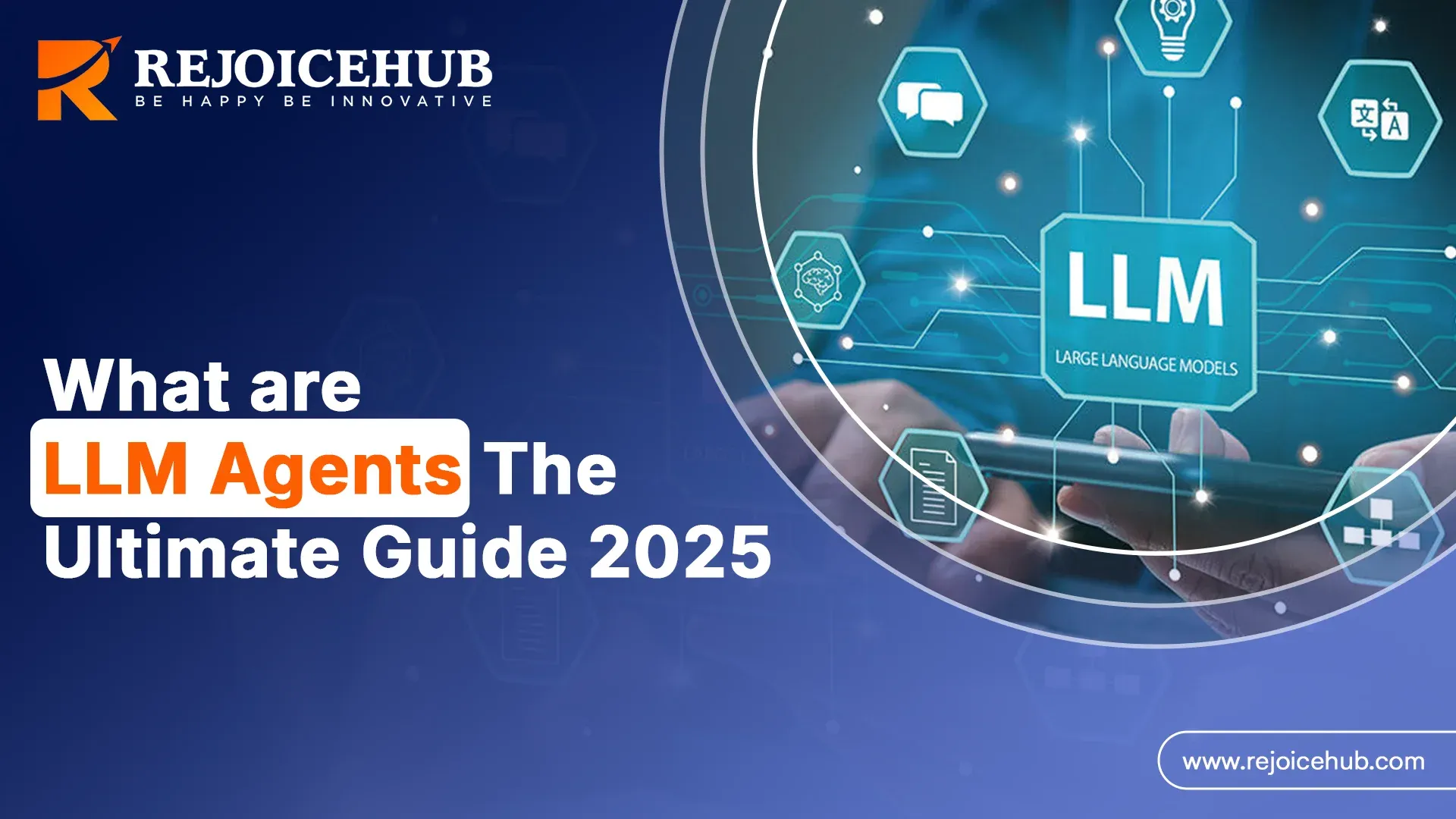
LLMs are getting smarter. And they are not working solo anymore.
So, what are they working with?
LLM agents, obviously.
LLMs are the brains. But brains alone can't drive a car or cook dinner or reply to 50 emails at once. But LLM agents can. They are the hands, the planner, the multitasker and the one who gets things done.
In 2025, AI is helping people in getting things done. LLM agents can automate tasks, summarize long documents and handle research. They use texts to plan, decide, learn from mistakes and improve over time. These AI tools are still becoming more powerful.
Let's understand what LLM agents are. How they work. Why are they involved in the future of AI?
Quick Summary
Large Language Models (LLMs) are advanced AI systems designed to understand, plan, and execute tasks autonomously. They possess capabilities such as content creation, data analysis, and customer support. These systems consist of several key components, including memory, the brain (the LLM itself), tools, and planning modules. However, LLMs also face challenges like effective context management, sensitivity to prompts, and high operational costs.
What Are LLM Agents?
LLM agents are AI systems. It combines the language understanding of large language models with the ability to plan and execute tasks. They do not respond but they act. They can:
- Interpret complex instructions.
- Break down tasks into manageable steps.
- Utilize tools and resources to achieve objectives.
- Learn from outcomes to improve future performance.
They are like virtual team members who can handle a variety of tasks. That also with minimal supervision.
What Can LLM Agents Do?
LLM (Large Language Model) agents are AI-powered systems that use language models like GPT to perform tasks autonomously or semi-autonomously. Here's a short overview of what they can do:

1. Self-reflection and improvement
LLM agents analyze their responses and detect errors. It refines their approach and improves over time. They continuously learn from mistakes. This makes them smarter and more effective with every interaction.
2. Transformer architecture
They use a deep learning model. It is called a transformer. It processes vast amounts of text, understands context and generates coherent responses. This architecture powers their ability. It is to communicate and adapt dynamically.
3. Multi-agent framework
LLM agents can work with other AI agents. It can assign tasks, share insights and collaborate on solutions. This teamwork increases efficiency and expands their ability to handle complex problems.
4. Tool use
They integrate with external tools like search engines, APIs and databases. It is to go beyond text generation. This allows them to fetch real-time information, execute tasks and provide valuable insights.
How do LLM agents do it?
LLM (Large Language Model) agents combine language models like GPT-4 with tools, memory, and goals to perform tasks autonomously. Here's a short overview of how they work:

-
Natural Language Generation (NLG)
They create text based on input that is like humans. They generate coherent, context-aware responses, summaries and content effortlessly by learning patterns from vast amounts of language data.
-
Natural Language Understanding (NLU)
They comprehend and interpret human language. It is possible by grasping meaning, intent and nuances. NLU allows them to analyze conversations, respond appropriately and even detect tone or sentiment for more meaningful interactions.
What are the components of LLM agent?
An LLM (Large Language Model) agent is a system that uses an LLM (like GPT-4) to perform tasks autonomously or semi-autonomously. Here’s a short overview of its core components:

1. Memory
LLM agents remember past conversations. It is by helping them give better answers. They use this memory to understand context and improve over time. This makes interactions smarter and more useful.
2 Brain
Their "brain" is the AI model. It processes language. It reads, understands and responds using advanced learning techniques. It helps it think, make decisions and generate meaningful answers.
3. Tools
LLM agents use tools like search engines, APIs and databases. These tools help them find information. It even completes the tasks and does more than just generate text-based responses.
4. Planning
They can plan steps, break down tasks and organize workflows. This ability helps them work efficiently. It solves problems and makes sure their responses and actions are well-structured.
Also Read: What is a Model Context Protocol server (MCP)?
Architecture of LLM agent
The architecture of a Large Language Model (LLM) agent typically involves several key components designed to process and generate human-like text.

1. Encoder-decoder structure
This framework helps AI in understanding and generating text. The encoder processes input. The decoder transforms it into meaningful responses. It is used in translation and conversational AI.
2. Transformer architecture
This deep learning model allows AI. It is to process large amounts of text efficiently. It uses attention mechanisms to understand context. This makes language generation more accurate and coherent.
3. Fine-tuning
AI models are refined using specific datasets after pre-training. It is to improve performance in targeted tasks. Those include customer support, coding and summarization. This makes responses more relevant and specialized.
4. Large-scale pre-training
LLMs are trained on vast datasets, learning patterns, grammar and context from millions of texts. This is before fine-tuning. This broad training helps them generate natural and informed responses.
Types of LLM agents
LLM (Large Language Model) agents are AI systems designed to interact with users, process large amounts of natural language data, and perform tasks autonomously or semi-autonomously. They can be categorized based on their functionality, interaction style, and domain expertise. Here’s an overview of different types of LLM agents:
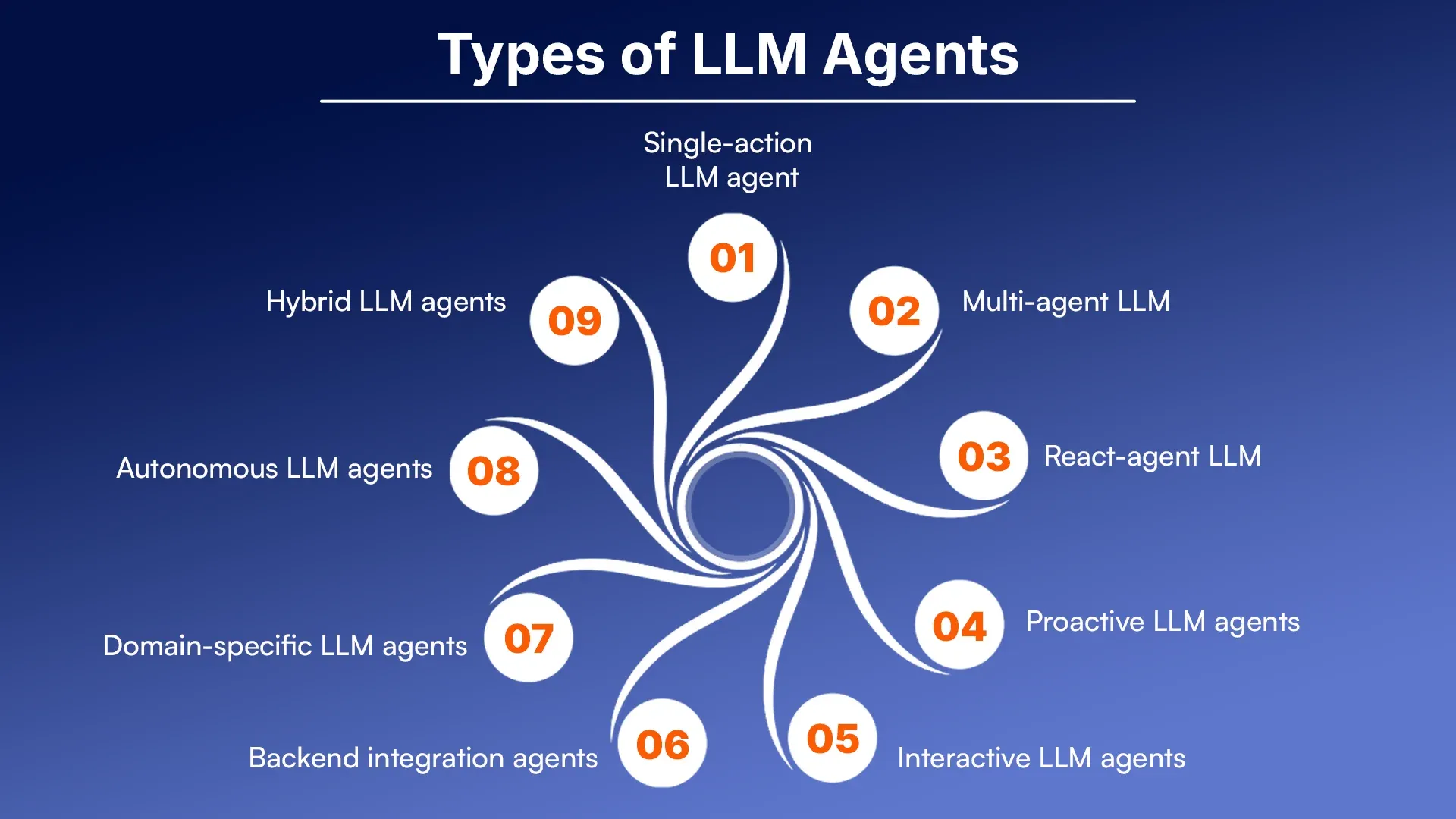
1. Single-action LLM agent
It focuses on one task. That task could be answering a question or translating text. It gives quick and straightforward responses. That should be without handling multiple complex tasks.
2. Multi-agent LLM
It works with other AI agents to complete tasks. They share data, divide work and collaborate. It is to solve complex problems. This makes teamwork possible between different AI models.
3. React-agent LLM
It quickly responds to user input and changing situations. It adapts to conversations, follows commands and adjusts its answers. This is based on real-time data. It is also based on the latest updates.
4. Proactive LLM agents
It takes action on its own. That also without waiting for a command. They suggest ideas and offer solutions. It even anticipates needs. It is based on patterns and past interactions.
5. Interactive LLM agents
It engages in back-and-forth conversations. They ask questions and guide users through tasks. It provides clear explanations. It is to improve understanding and help with decision making.
6. Backend integration agents
It connects AI with databases, APIs and software systems. They retrieve data, send requests and automate tasks. This is to improve workflow. This is possible without human-intervention.
7. Domain-specific LLM agents
It focuses on specific industries. Those industries can be healthcare, finance or law. They provide expert insights. It offers customized solutions. It is based on in-depth knowledge of a particular field.
8. Autonomous LLM agents
It works independently with minimal human input. They analyze information, make decisions and solve problems. That also does not need direct supervision or step-by-step instructions.
9. Hybrid LLM agents
It combines multiple AI capabilities. They can answer questions, automate tasks, integrate with external tools and adapt to different needs. This makes them highly flexible and versatile.
Also Read: What is AI Automation? All You Need to Know
How LLM agents use tools?
LLM (Large Language Model) agents use tools by integrating external functionalities through APIs or plugins to enhance their capabilities. These tools allow LLM agents to perform actions like accessing databases, making web requests, executing code, or interacting with other services beyond their pre-trained knowledge.
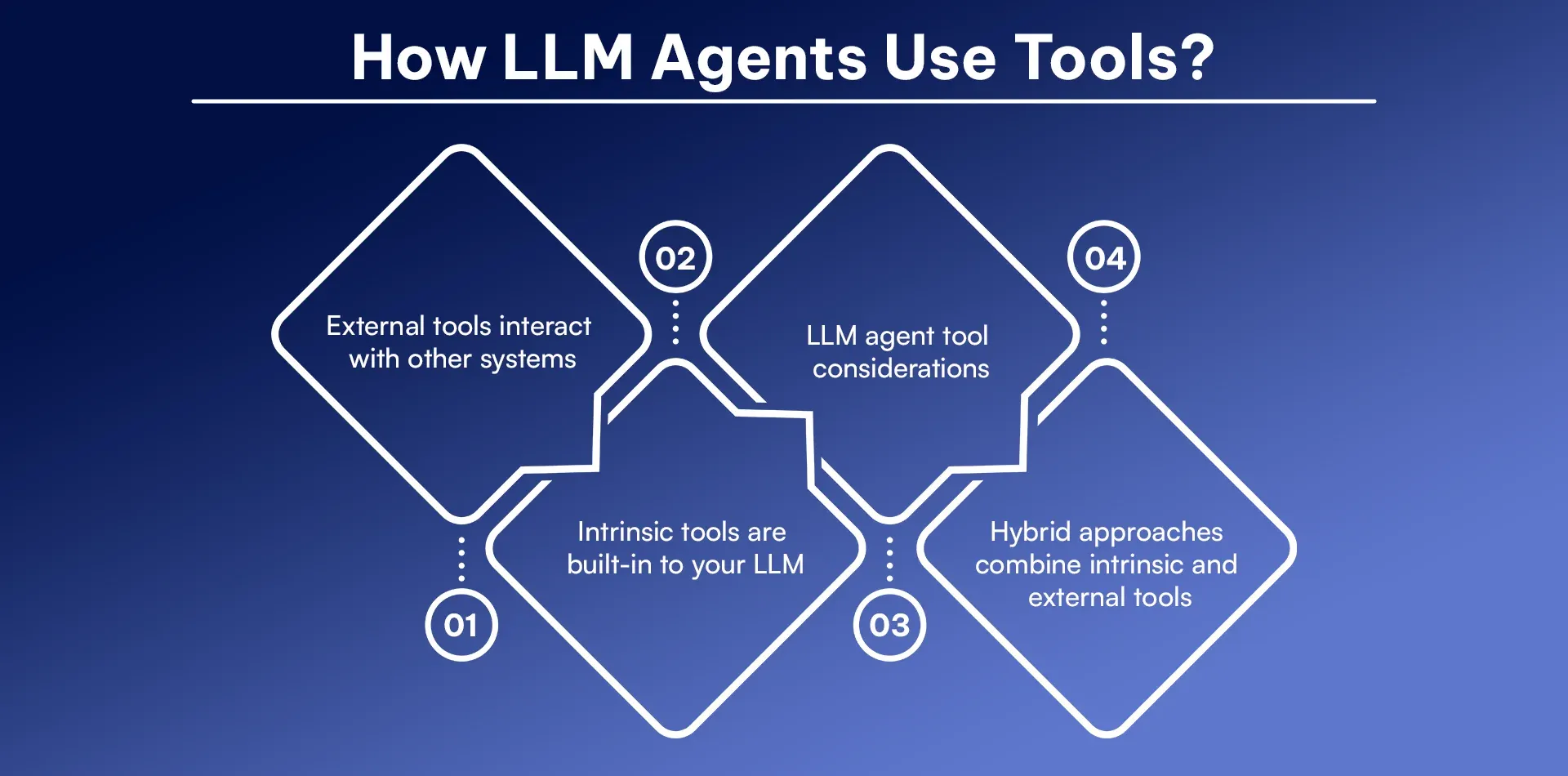
1. External tools interact with other systems
LLM agents connect with search engines and APIs. Along with that it even connects with databases. This is to fetch real-time information and process data. LLM agents execute tasks beyond text generation.
2. Intrinsic tools are built-in to your LLM
Some functions like logic, summarization and reasoning are embedded within the AI itself. This is done by allowing it to perform complex tasks.
That is also without the need for external connections.
3. LLM agent tool considerations
They choose the right tool. It depends on the task, accuracy, and efficiency needed. Agents must balance speed, security and reliability when deciding how to process information.
4. Hybrid approaches combine intrinsic and external tools
Many LLM agents use a mix of built-in logic and external resources. This ensures flexibility in handling simple tasks. It is within the model while making use of external tools for advanced operations.
What are the Benefits of LLM agents?
LLM agents offer several key benefits:
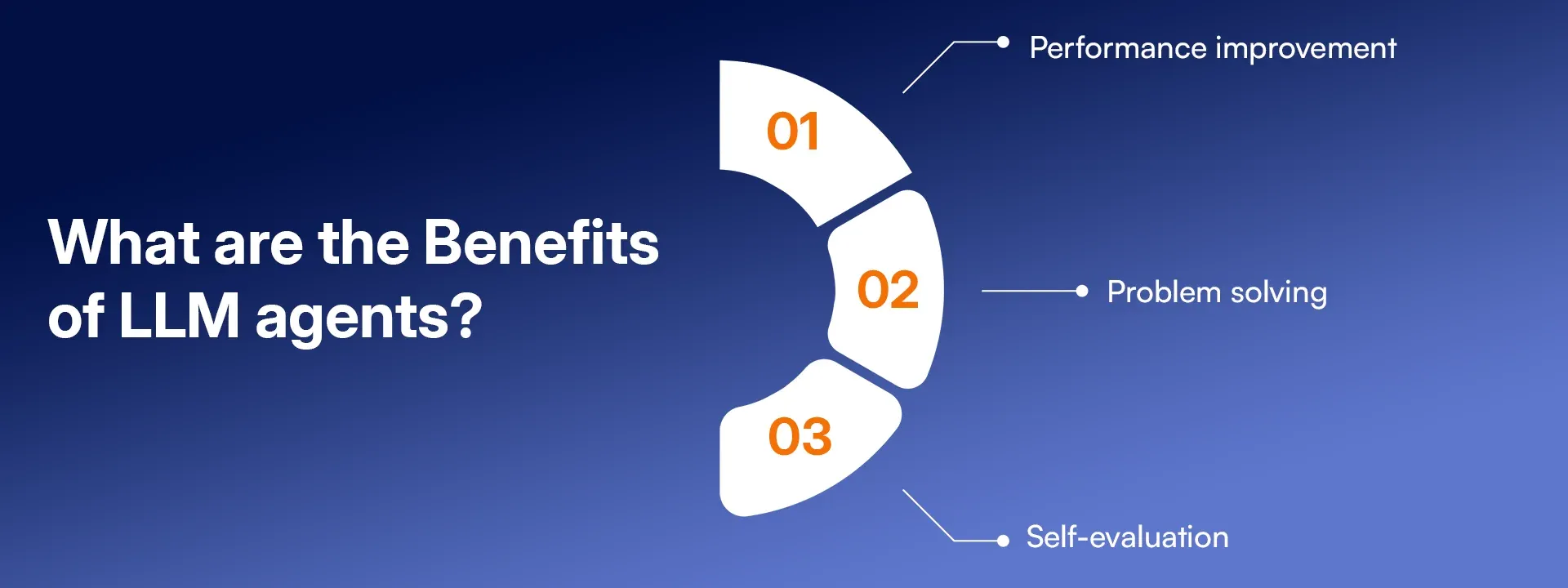
-
Performance improvement
They optimize workflows and automate repetitive tasks. They process vast amounts of information quickly and faster. This helps businesses and individuals by working faster and smarter.
-
Problem solving
They analyze complex scenarios and provide solutions. They assist in decision-making. It is possible by understanding patterns and generating insights. It is based on large datasets.
-
Self-evaluation
They assess their responses and learn from feedback. They refine their accuracy over time. This is done by making sure that improvement in understanding is continuous and communication.
What are the Challenges of LLM agent?
Large Language Model (LLM) agents, while powerful, face several challenges:
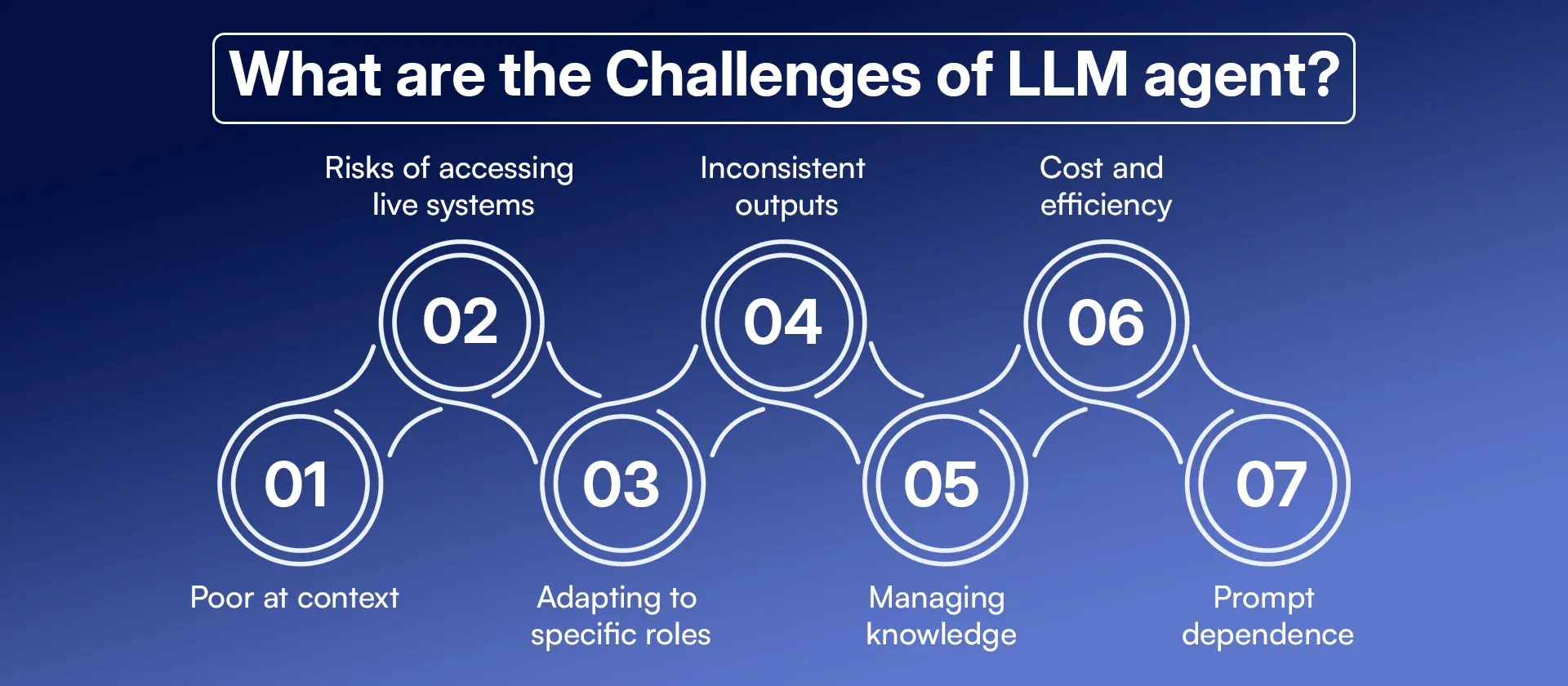
1. Poor at context
LLM agents sometimes struggle to follow long conversations. They may forget previous details, misinterpret meaning or fail to maintain consistency. It affects accuracy in complex discussions and decision-making.
2. Risks of accessing live systems
Connecting to real-time data can pose security risks. AI systems must carefully manage permissions to prevent errors, data breaches and unintended actions that could impact sensitive operations.
3. Adapting to specific roles
Training LLM agents for specialized industries is challenging. They require personalized datasets, domain-specific knowledge and fine-tuning. It ensures accuracy and relevance in fields like healthcare, finance, and law.
4. Inconsistent outputs
Responses may vary due to data limitations or complex prompts. AI may generate misleading, vague or contradictory answers. It requires careful validation and refinement to improve reliability.
5. Managing knowledge
AI struggles to keep information up to date. Without regular updates and outdated facts may lead to incorrect responses. This makes knowledge management a critical part of LLM agent development.
6. Cost and efficiency
Running large AI models requires high computational power. This makes them expensive. Developers must balance speed, accuracy and processing costs. Along with that they should ensure efficient performance in various applications.
7. Prompt dependence
AI responses depend on well-structured prompts. Poorly phrased questions can lead to unclear or misleading answers. This emphasizes the importance of precise input for effective AI interactions.
Conclusion
LLM agents are the next change of smart AI. They answer your questions, they think, they plan, and they act. They handle tasks, use tools and improve over time. They are designed to work as if they are digital teammates.
Yes, there are still some challenges. But the potential is huge. LLM agents will be part of how we work, learn and solve problems every day. These systems are getting smarter. The future of AI is proactive, interactive and changing. LLM agents are leading.
If you're ready to harness this power, RejoiceHub offers advanced LLM agent services to help businesses automate smarter, work faster, and grow with AI.
Frequently Asked Questions
Are LLM agents and chatbots the same?
Not quite.
Can I build my own LLM agent?
Yes, with the right tools and knowledge.
Are LLM agents safe to use?
They can be.
Why do LLM agents forget past conversations?
LLM agents process each prompt separately
